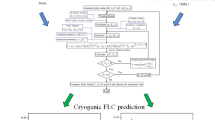Abstract
Cold upset forming and densification features in sintered aluminum preforms using different lubricants were investigated. Cylindrical preforms with initial density 91% of the theoretical one and aspect radio 0.75 were prepared on a 0.1 MN capacity universal testing machine. The preforms were covered with dry fine silica sand and sintered at 520±10°C for 1 h. Cold deformation experiments were carried out in several steps. In general, each compact was subjected to compressive loading in steps of 0.01 MN until fine cracks appeared on its free surface. The experimental data showed that grease exhibits enhanced densification compared to that for MoS2 or graphite lubricants, provided that the initial preform density and aspect ratio are kept constant. The instantaneous strain hardening exponent and strength coefficient of the preforms were calculated and found to reach a peak value when the deformation or packing density were low. Further, they decreased and became constant. The initial geometry of the P/M preforms was shown to play a predominant role in influencing them.
Similar content being viewed by others
REFERENCES
A. H. Shabaik, “Prediction on the geometry changes of the free boundary during upsetting by the slip line theory,” J. Eng. Ind., 586–592 (1971).
C. H. Lee, T. Altan, “Influence of flow stress and friction upon metal flow in upset forging of rings and cylinders,” J. Eng. Ind., 775–782 (1972).
M. S. J. “Upsetting of cylindrical billets between flat platens having unequal frictional properties,” Int. J. Mach. Tool. Des., Res., 18, 189–196 (1978).
D. Y. Yang, Y. Choi, J. H. Kim, “Analysis of upset forging of cylindrical billets considering the dissimilar frictional conditions at two flat die surfaces,” Int. J. Mach. Tools Manufactory, 31, No. 3, 397–404 (1991).
T. Tabata, S. Masaki, “Coefficient of friction between metal powder and wall during compaction,” Powder Metall. Int., 13, 179 (1982).
K. S. Pandey, “Feasibility of hot axial forging of sintered hypereutectoid composition,” Proc. 15 th National AIMTDR Conf., PSG College of Technology, India (1992), D17/1-D17/6.
R. Narayanasamy, K. S. Pandey, “Salient features in the cold upset forming of aluminium-3,5% alumina power composite performs,” J. Mat. Proces. Technol., 72, 201–207 (1997).
K. J. Kahlow, Void Behavior as Influenced by Pressure and Plastic Deformation," Report, Institute for Metal Forming, Lehigh University (1971), pp. 10–16.
R. Narayanasamy, K. S. Pandey, “Some aspects of work hardening in sintered aluminium-iron composite preforms during cold axial forming,” J. Mat. Process. Technol., 84, 136–142 (1998).
R. Narayanasamy, K. S. Pandey, “Phenomenon of barrelling in aluminium solid cylinder during cold upset forming,” J. Mat. Technol., 70, 17–21 (1997).
Author information
Authors and Affiliations
Rights and permissions
About this article
Cite this article
Selvakumar, N., Narayanasamy, R. & Pandey, K. Some Aspects of Cold Upset Forming of Sintered Aluminum Preforms Using Different Lubricants. Powder Metallurgy and Metal Ceramics 43, 349–354 (2004). https://doi.org/10.1023/B:PMMC.0000048128.48739.91
Issue Date:
DOI: https://doi.org/10.1023/B:PMMC.0000048128.48739.91




